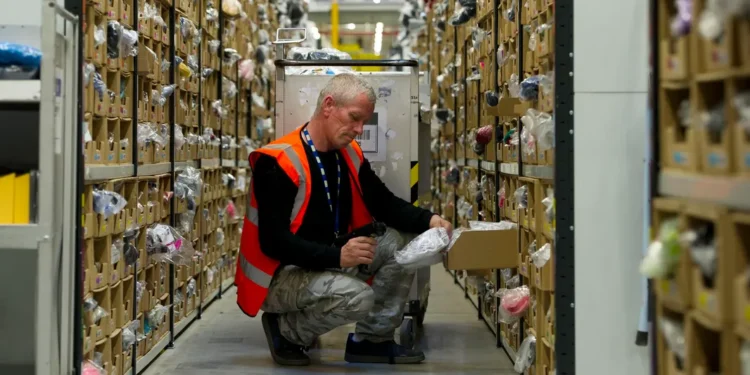Amazon is preparing to eliminate approximately 30,000 corporate positions this week, according to a Monday report citing sources familiar with the company’s plans.
The job cuts, expected to be announced Tuesday, would mark the largest single workforce reduction in Amazon’s history. The company previously conducted two rounds of layoffs during late 2022 and early 2023 that resulted in 27,000 total job losses.
Since 2023, Amazon has implemented smaller, targeted reductions affecting specific teams and business units. In July, the company eliminated several hundred positions within its cloud computing division, following a pattern of selective cuts throughout 2024.
Amazon representatives have not responded to requests for comment on the reported layoffs.
While the 30,000 job eliminations represent a small fraction of Amazon’s total workforce exceeding 1.55 million employees, the cuts would affect nearly 10% of the company’s corporate staff working in headquarters and satellite offices.
The 30,000 corporate layoffs surpassing the previous 27,000-employee reduction record demonstrates Amazon’s willingness to conduct unprecedented workforce contractions when CEO Andy Jassy determines headcount reductions necessary for profitability targets.
The Tuesday announcement timing suggests Amazon coordinated the cuts to occur mid-week rather than Friday afternoon, potentially indicating company desire to provide affected employees immediate access to HR support and outplacement services during regular business hours.
The corporate employee focus means the layoffs will disproportionately impact Seattle headquarters and satellite offices in Bellevue, rather than warehouse workers or delivery drivers who comprise the majority of Amazon’s 1.55 million total workforce.
The 10% corporate staff reduction indicates systematic restructuring across multiple divisions rather than eliminating specific underperforming business units, suggesting Amazon believes its white-collar workforce expanded beyond sustainable levels during pandemic-era hiring.
The pattern of smaller 2024 cuts preceding massive Tuesday layoffs suggests Amazon either misjudged initial reduction needs or faced deteriorating business conditions throughout the year that necessitated escalating workforce adjustments.
The July cloud computing division cuts foreshadowed broader reductions, as AWS typically represents Amazon’s highest-margin business where even profitable divisions face efficiency mandates when corporate leadership pursues cost optimization.
Amazon’s reluctance to comment before formal announcements follows standard practice where companies avoid confirming layoff reports to prevent employee panic and productivity collapse in the hours before official notifications.
The 1.55 million total workforce figure including warehouse and logistics staff obscures the corporate layoffs’ concentrated impact on knowledge workers earning six-figure salaries in technology, marketing, finance, and administrative roles.
Seattle’s economy faces significant consequences from 30,000 Amazon corporate layoffs, as affected employees reduce spending at restaurants, retailers, and service businesses throughout the metropolitan area while seeking new employment.
The layoffs will flood Seattle’s technology job market with thousands of experienced corporate workers simultaneously seeking positions, depressing wages and extending unemployment durations as supply overwhelms demand for skilled professionals.
Amazon’s South Lake Union and downtown Seattle office spaces may see reduced occupancy following layoffs, potentially triggering sublease activity that adds to commercial real estate oversupply plaguing the city since pandemic remote work adoption.
The timing before year-end holidays suggests Amazon aims to complete restructuring before 2026 begins, allowing the company to report reduced headcount in upcoming quarterly earnings that demonstrate cost discipline to Wall Street analysts.
Former Amazon employees receiving severance packages will face challenging job searches in a technology sector where Meta, Google, Microsoft, and other major employers also conducted recent layoffs, creating unprecedented competition for available positions.
Washington state unemployment insurance claims will spike following the layoffs, straining systems as thousands of corporate workers file simultaneously for benefits while conducting job searches potentially lasting months given market saturation.
The corporate layoffs contrast with Amazon’s continued hiring of warehouse workers and delivery drivers supporting e-commerce operations, illustrating divergent labor strategies where the company expands low-wage frontline workforce while contracting expensive corporate overhead.
Local technology recruiters anticipate surge in Amazon alumni seeking placement, as 30,000 newly unemployed corporate employees represent massive talent pool that smaller Seattle companies typically cannot access when Amazon retains workers through competitive compensation.
The layoffs’ magnitude exceeding previous records signals potential shift in Amazon culture from aggressive growth prioritizing innovation and market expansion toward mature company focus on profitability margins and operational efficiency.







